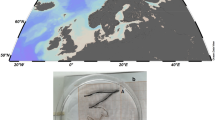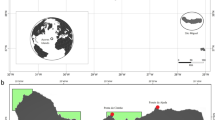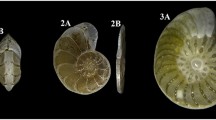Abstract
High densities of the wood-boring bivalve Xylophaga atlantica colonized pine wood cubes in colonization devices deployed at 2279 m depth for 414 days (14 July 2007–31 August 2008) near hydrothermal vents at the Rainbow site on the Mid-Atlantic Ridge (36°13.7454′N/33°54.0513′W). Histological and biometric observations on specimens with shell lengths (SLs) of 0.5–4.2 mm revealed three cohorts in this dioecious population. The first cohort was dominated by mature females, each with an estimated fecundity of ~450 oocytes with a mean diameter of 28.0 ± 3.9 µm (maximum diameter 40.0 µm); an intermediate cohort was a mix of males and females with SL at first maturity of ≤1.7 mm; the third cohort was exclusively morphologically distinct, mature, dwarf males, SL ~500 µm. These dwarf males were attached to the dorsal shell surfaces of females in the first cohort. The difference in the SL of Prodissoconch I (~60 µm) and Prodissoconch II (500–530 µm) confirmed planktotrophy. Based on their carbon and nitrogen stable isotope ratios, and a paedomorphic morphology suggesting they are ill-equipped to bore wood, it seems likely that the dwarf males are heterotrophic filter-feeders. Fluorescence in situ hybridization showed, however, that dwarf males hosted a few Gammaproteobacteria in their gills. The absence of a bacterial signal in the germ cells and developing oocytes of females implies that direct trans-ovarial inheritance of symbiotic bacteria does not occur in X. atlantica.




Similar content being viewed by others
References
Altschul SF, Madden TL, Schäffer AA, Zhang J, Zhang Z, Miller W et al (1997) Gapped BLAST and PSI-BLAST: a new generation of protein database search programs. Nucl Acids Res 25:3389–3402
Amann R, Krumholz L, Stahl D (1990) Fluorescent-oligonucleotide probing of whole cells for determinative, phylogenetic, and environmental-studies in microbiology. J Bacteriol 172:762–770
Amon DJ, Sykes D, Ahmed F, Copley JT, Kemp KM, Tyler PA, Young CM, Glover AG (2015) Burrow forms, growth rates and feeding rates of wood-boring Xylophagaidae bivalves revealed by micro-computed tomography. Front Mar Sci. doi:10.3389/fmars.2015.00010
Arellano SM, Gaest ALV, Johnson SB, Vrijenhoek RC, Young CM (2014) Larvae from deep-sea methane seeps disperse in surface waters. Proc R Soc B 281:20133276. doi:10.1098/rspb.2013.3276
Berec L, Schembri PJ, Boukal DS (2005) Sex determination in Bonellia viridis (Echiura: Bonelliidae): population dynamics and evolution. Oikos 108:473–484
Berg C, Early J, Butman B, Turner R (1987) Seasonal recruitment of marine invertebrates to hard substrates on Georges Bank and the eastern continental-shelf of the United-States. Nautilus 101:19–24
Canals M, Puig P, de Madron XD, Heussner S, Palanques A, Fabres J (2006) Flushing submarine canyons. Nature 444:354–357
Chávez-Villalba J, Soyez C, Huvet A, Gueguen Y, Lo C, Moullac GL (2011) Determination of gender in the Pearl Oyster Pinctada margaritifera. J Shellfish Res 30:231–240
Culliney IL, Turner RD (1976) Larval development of the deep-water wood boring bivalve, Xylophaga atlantica Richards (Mollusca, Bivalvia, Pholadidae). Ophelia 15:149–161
Cunha MR, Matos FL, Génio L, Hilário A, Moura CJ, Ravara A, Rodrigues CF (2013) Are organic falls bridging reduced environments in the deep sea? Results from colonization experiments in the Gulf of Cádiz. PLoS One 8:e76688
DeNiro MJ, Epstein S (1978) Influence of diet on the distribution of carbon isotopes in animals. Geochim Cosmochim Acta 42:495–506
Distel DL, Roberts SJ (1997) Bacterial endosymbionts in the gills of the deep-sea wood-boring bivalves Xylophaga atlantica and X. washingtona. Biol Bull 192:253–261
Distel DL, Beaudoin DJ, Morrill W (2002a) Coexistence of multiple proteobacterial endosymbionts in the gills of the wood-boring bivalve Lyrodus pedicellatus (Bivalvia: Teredinidae). Appl Environ Microbiol 68:6292–6299
Distel DL, Morrill W, MacLaren-Toussaint N, Franks D, Waterbury J (2002b) Teredinibacter turnerae gen. nov., sp. nov., a dinitrogen-fixing, cellulolytic, endosymbiotic gamma-proteobacterium isolated from the gills of wood-boring molluscs (Bivalvia: Teredinidae). Int J Syst Evol Microbiol 52:2261–2269
Distel DL, Amin M, Burgoyne A, Linton E, Mamangkey G, Morril W, Nove J, Wood N, Yang J (2011) Molecular phylogeny of Pholadoidea Lamarck, 1809 supports a single origin for xylotrophy (wood feeding) and xylotrophic bacterial endosymbiosis in Bivalvia. Mol Phylogenet Evol 61:54–70
Duperron S, Nadalig T, Caprais J-C, Sibuet M, Fiala-Médioni A, Amann R, Dubilier N (2005) Dual symbiosis in a Bathymodiolus sp. mussel from a methane seep on the Gabon continental margin (Southeast Atlantic): 16S rRNA phylogeny and distribution of the symbionts in gills. Appl Environ Microbiol 71:1694–1700
Duperron S, Pottier M-A, Leger N, Gaudron SM, Puillandre N, Le Prieur S et al (2013) A tale of two chitons: is habitat specialisation linked to distinct associated bacterial communities? FEMS Microbiol Ecol 83:552–567
Fagervold SK, Romano C, Kalenitchenko D, Borowski C, Nunes-Jorge A, Martin D, Galand PE (2014) Microbial communities in sunken wood are structured by wood-boring bivalves and location in a submarine canyon. PLoS ONE 9:e96248
FAO (2002) FISAT-II, Software version 1.1.2. FAO-ICLARM stock assessment tools, Rome. http://www.fao.org/fishery/topic/16072/en
Gaudron SM, Pradillon F, Pailleret M, Duperron S, Le Bris N, Gaill F (2010) Colonization of organic substrates deployed in deep-sea reducing habitats by symbiotic species and associated fauna. Mar Environ Res 70:1–12
Gaudron SM, Demoyencourt E, Duperron S (2012) Reproductive traits of the cold-seep symbiotic mussel Idas modiolaeformis: gametogenesis and larval biology. Biol Bull 222:6–16
Génio L, Rodrigues CF, Guedes IF, Almeida H, Duperron S, Hilário A (2015) Mammal carcasses attract a swarm of mussels in the deep Atlantic: insights into colonization and biogeography of a chemosymbiotic species. Mar Ecol 36:71–81
Haga T, Kase T (2013) Progenetic dwarf males in the deep-sea wood-boring genus Xylophaga (Bivalvia: Pholadoidea). J Mollus Stud 79:90–94
Hilário A, Metaxas A, Gaudron SM, Howell KL, Mercier A, Mestre NC, Ross RE, Thurnherr AR, Young CM (2015) Estimating dispersal distance in the deep sea: challenges and applications to marine reserves. Front Mar Sci. doi:10.3389/fmars.2015.00006
Jablonski D, Lutz R (1983) Larval ecology of marine benthic invertebrates—paleobiological implications. Biol Rev Camb Philos Soc 58:21–89
Knudsen J (1961) The bathyal and abyssal Xylophaga (Pholadidae, bivalvia). Danish Science Press Ltd., Copenhagen
Laming SR, Duperron S, Gaudron SM, Cunha MR (2014) Settled, symbiotic then sexually mature: adaptive developmental anatomy in the deep-sea, chemosymbiotic mussel Idas modiolaeformis. Mar Biol 161:1319–1333
Laming SR, Duperron S, Gaudron SM, Hilário A, Cunha MR (2015) Adapted to change: the rapid development of symbiosis in newly settled, fast-maturing chemosymbiotic mussels in the deep sea. Mar Environ Res 112:100–112
Manz W, Amann R, Ludwig W, Wagner M, Schleifer K-H (1992) Phylogenetic oligodeoxynucleotide probes for the major subclasses of Proteobacteria: problems and solutions. Syst Appl Microbiol 15:593–600
Minagawa M, Wada E (1984) Stepwise enrichment of 15N along food chains: further evidence and the relation between d15N and animal age. Geochim Cosmochim Acta 48:1135–1140
Nishimoto A, Mito S, Shirayama Y (2009) Organic carbon and nitrogen source of sunken wood communities on continental shelves around Japan inferred from stable isotope ratios. Deep Sea Res 56:1683–1688
O’Connor RM, Fung JM, Sharp KH, Benner JS, McClung C, Cushing S et al (2014) Gill bacteria enable a novel digestive strategy in a wood-feeding mollusk. Proc Natl Acad Sci USA 111:e5096–e5104
Ockelmann KW, Dinesen GE (2011) Life on wood—the carnivorous deep-sea mussel Idas argenteus (Bathymodiolinae, Mytilidae, Bivalvia). Mar Biol Res 7:71–84
Olu K, Cordes EE, Fisher CR, Brooks JM, Sibuet M, Desbruyères D (2010) Biogeography and potential exchanges among the Atlantic equatorial belt cold-seep faunas. PLoS ONE 5:e11967. doi:10.1371/journal.pone.0011967
Purchon RD (1941) On the biology and relationships of the lamellibranch Xylophaga dorsalis (Turton). J Mar Biol Assoc UK 25:1–39
Richards HG (1942) Xylophaga atlantica, new species. Nautilus 56:68
Rodrigues CF, Laming SR, Gaudron SM, Oliver G, Le Bris N, Duperron S (2015) A sad tale: has the small mussel Idas argenteus lost its symbionts? Biol J Linn Soc 114:398–405
Romano C, Voight JR, Company JB, Plyuscheva M, Martin D (2013) Submarine canyons as the preferred habitat for wood-boring species of Xylophaga (Mollusca, Bivalvia). Prog Oceanogr 118:175–187
Romano C, Voight JR, Pérez-Portela R, Martin D (2014) Morphological and genetic diversity of the wood-boring Xylophaga (Mollusca, Bivalvia): new species and records from deep-sea Iberian canyons. PLoS ONE 9:e102887
Romey W, Castro K, Dealteris J, Bullock R (1991) Recruitment in the deep-sea wood-boring bivalve Xylophaga atlantica Richards. Veliger 34:14–20
Romey W, Bullock R, Dealteris J (1994) Rapid growth of a deep-sea wood-boring bivalve. Cont Shelf Res 14:1349–1359
Rouse GW, Goffredi SK, Vrijenhoek RC (2004) Osedax: bone-eating marine worms with dwarf males. Science 305:668–671
Santerre C, Sourdaine P, Marc N, Mingant C, Robert R, Martinez A-S (2013) Oyster sex determination is influenced by temperature—first clues in spat during first gonadic differentiation and gametogenesis. Comp Biochem Phys A 165:61–69
Szafranski KM, Deschamps P, Cunha MR, Gaudron SM, Duperron S (2015) Colonization of plant substrates at hydrothermal vents and cold seeps in the northeast Atlantic and Mediterranean and occurrence of symbiont-related bacteria. Front Microbiol 6:162. doi:10.3389/fmicb.2015.00162
Thiel M, Gutow L (2005) The ecology of rafting in the marine environment. II. The rafting organisms and community. Oceanogr Mar Biol 43:279–418
Turner R (1973) Wood-boring bivalves, opportunistic species in the deep sea. Science 180:1377–1379
Turner R (2002) On the subfamily Xylophagainae (Family Pholadidae, Bivalvia, Mollusca). Bull MusComp Zool 157:223–307
Tyler PA, Young CM, Dove F (2007) Settlement, growth and reproduction in the deep-sea wood-boring bivalve mollusc Xylophaga depalmai. Mar Ecol Prog Ser 343:151–159
Voight JR (2008) Deep-sea wood-boring bivalves of Xylophaga (Myoida: Pholadidae) on the continental shelf: a new species described. J Mar Biol Assoc UK 88:1459–1464
Voight JR (2015) Xylotrophic bivalves: aspects of their biology and the impacts of humans. J Mollus Stud 81:175–186
Voight JR, Segonzac M (2012) At the bottom of the deep blue sea: a new wood-boring bivalve (Mollusca, Pholadidae, Xylophaga) from the Cape Verde Abyssal Plain (subtropical Atlantic). Zoosystema 34:171–180
Wallner G, Amann R, Beisker W (1993) Optimizing fluorescent in situ hybridization with rRNA-targeted oligonucleotide probes for flow cytometric identification of microorganisms. Cytometry 14:136–143
Waterbury JB, Calloway CB, Turner RD (1983) A cellulolytic nitrogen-fixing bacterium cultured from the gland of Deshayes in shipworms (Bivalvia: Teredinidae). Science 221:1401–1403
Williams ST, Reid DG (2004) Speciation and diversity on tropical rocky shores: a global phylogeny of snails of the genus Echinolittorina. Evolution 58:2227–2251
Young CM, Emson RH, Rice ME, Tyler PA (2013) A paradoxical mismatch of fecundity and recruitment in deep-sea opportunists: cocculinid and pseudococculinid limpets colonizing vascular plant remains on the Bahamian Slope. Deep Sea Res 92:36–45
Acknowledgments
Authors would like to thank the people who have deployed and recovered the CHEMECOLIs: Delphine Cottin and Amandine Nunes Jorge. We are grateful to chief scientists, captains and crews of RVs Pourquoi pas? and L’Atalante, and teams operating ROVs Victor 6000 (Ifremer, France) and submersible Nautile (Ifremer, France) during the cruises MOMARDREAM-07 and MOMARDEAM-08. Sample collection and construction of the CHEMECOLIs were funded by CHEMECO (European Sciences Foundation (ESF)/Eurocores/EURODEEP/0001/2007). Analyses and interpretation of data were supported by HERMIONE European Commission (FP7/2007-2013-no 226354), University of Pierre and Marie Curie and Institut Universitaire de France. S. Laming was co-funded by a MARES PhD grant (FPA2011-0016), a post-doctoral grant HERMIONE EC (FP7/2007-2013-no 226354). T. Haga was partially funded by a Grant-in-Aid for JSPS fellows (#198300 and #237855). We would like to thank C. Romano for interesting scientific exchanges on the biology and ecology of wood-boring bivalves. We would like to thank J. Voight on scientific exchanges regarding taxonomy. We would like to thank also V. Bazin (IFR83, UPMC) for a great experience with the scanning electron microscopy, N. Léger for her help with some of the preparation of in situ hybridization, and C. Rodrigues for running the PCRs and the two molecular sequence analyses.
Author information
Authors and Affiliations
Corresponding author
Ethics declarations
Conflict of interest
All authors declare that they have no conflict of interest.
Human and animal rights statement
All applicable international, national, and/or institutional guidelines for the care and use of animals were followed.
Additional information
Responsible Editor: J. Grassle.
Reviewed by Undisclosed experts.
Electronic supplementary material
Below is the link to the electronic supplementary material.
Rights and permissions
About this article
Cite this article
Gaudron, S.M., Haga, T., Wang, H. et al. Plasticity in reproduction and nutrition in wood-boring bivalves (Xylophaga atlantica) from the Mid-Atlantic Ridge. Mar Biol 163, 213 (2016). https://doi.org/10.1007/s00227-016-2988-6
Received:
Accepted:
Published:
DOI: https://doi.org/10.1007/s00227-016-2988-6




